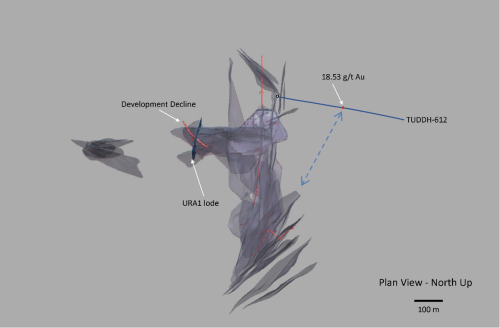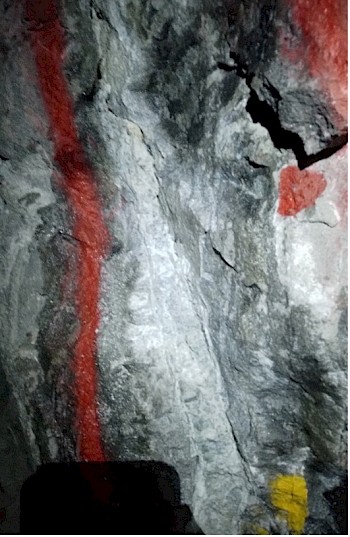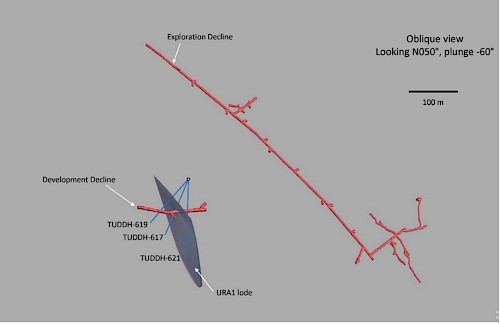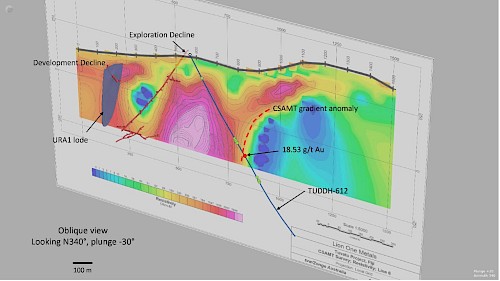North Vancouver, B.C., December 8, 2022 - Lion One Metals Limited (TSX-V: LIO) (OTCQX: LOMLF) (ASX: LLO) (“Lion One” or the “Company”) provides results from near-mine exploration, identifying two new zones of significant mineralization within the footprint of the deposit. A new lode, named URA1 has been discovered during construction of the development decline; its location corresponds to Tuvatu’s near-surface and earliest scheduled production area: Zone 2. The lode has been further defined through underground channel sampling and subsequent diamond drilling. The URA1 lode will be included in the updated Mineral Resource Estimate (MRE) that the Company aims to release in early 2023. Additionally, several hundred meters to the east of Tuvatu, drillhole TUDDH-612 has intersected mineralization corresponding to a distinct CSAMT gradient anomaly. This release presents significant new results from two separate areas within the general Tuvatu deposit footprint (Figure 1).
Highlights URA1
- Discovery of near-surface, high-grade URA1 lode from intersection with the development decline, defined through channel sampling (up to 29 g/t Au over 1m in MD-CH-002) and diamond drilling of holes TUDDH-617, 619, and 621 (up to 167.42g/t Au over 0.3m in TUDDH-617, and 27.99 g/t Au over 1.2m in TUDDH-621)
- Provides increase in volume of mineralized material within the portion of the deposit scheduled for earliest production.
- A general N-S orientation of the lode corresponds to other major lodes (e.g., URW1) and may indicate the presence of an additional series of undiscovered lodes further to the West of Tuvatu.
- Underscores the substantial near-mine exploration upside.
Highlights TUDDH-612
- New ore-grade mineralization of 18.53 g/t Au over 0.6m from 492m corresponding to a sharp CSAMT geophysical gradient anomaly.
- May represent the possible strike extension of the UR4 lode at Tuvatu, that may also include the deep high-grade intercept in TUDDH-494 at >1100m depth,
- Tuvatu itself is coincident with a CSAMT gradient of similar magnitude; the recurring correspondence of mineralization with such gradients provides strong validation for the viability of this method for discovery of additional mineralized centers in the caldera. Once completed, this data will provide robust drill targets and substantial projected upside for new discovery.
URA1 lode, Zone 2
During advancement of the 2022 development decline, approximately 75m from the portal entrance, a sharp, clearly defined quartz-sulfide lode was intersected striking NNE-SSW and dipping 84°SE (Figure 2a). This newly identified structure is defined through underground mapping and has control points in space from chip-channel sampling, (results: Table 1) and a three-hole DDH program (TUDDH-617, 619 and 621; Figure 2b) to test the extent of this new lode (results: Table 2). The lode is named URA1, and represents a completely new, previously unmapped structure occurring within the northwestern, near-surface portion of the Tuvatu deposit (Zone 2). The new occurrence discovered near-surface, in a portion of the Tuvatu orebody that is within the current resource estimation extents, illustrates the extraordinary upside potential of the Tuvatu orebody in general. Table 2 lists the interpreted lode for each of the mineralized intercepts in boreholes TUDDH-617, 619, and 621. It is notable that the high-grade intercepts near the bottom of hole TUDDH-617 between 140.1 and 144.6m remain undefined, potentially representing yet another new lode. Moreover, this illustrates the discovery potential of additional mineralization, especially toward the West Zone where relatively sparse drilling has been completed. Notably, this area is defined by historic drilling carried out at a N-S orientation, which would have limited the exposure of the drilling to mineralized lodes trending in the same orientation.
As the discovery and definition of new features continues to add upside, intersection with known lodes, like the Murau 8 lode, intersected with TUDDH-621 at 105.3m returning 4.8m at 30.75 g/t gold continues to provide confidence in the grade continuity of known lodes.
TUDDH-612 and CSAMT profile 6
As part of the Company’s ongoing near-mine exploration program, drillhole TUDDH-612 was completed to test the sharply defined CSAMT1 gradient anomaly on profile 6 (Figure 3). Drill hole TUDDH-612 intersected 18.53 g/t Au over 0.6m at 491.8m depth along the borehole.
As shown in Figure 1, this area is located several hundred meters from the current Tuvatu mineral resource outline. As such, the mineralization intersected at this location represents a new target zone of potential high-grade mineralization that warrants follow-up. Furthermore, the mineralized intercept in hole TUDDH-612 corresponds closely to the strike projection of the UR4 lode, along with the previously reported, deep intercept in TUDDH-494 of 12.2 g/t Au at a depth along the hole of 1106.3m (see April 8, 2022 news release). As such, these intercepts may indicate the extension of the UR4 lode toward the northeast and at depth, increasing LIO’s confidence that the mineralized structure has continuity over space for several hundred meters both to the east and at depth. This structure remains open along strike and up and down dip.
The mineralization observed (Figure 3) corresponds directly with a sharply defined CSAMT gradient anomaly, thus lending significant credence to the application of CSAMT for targeting new zones of potential mineralization. The infill CSAMT survey lines completed in 2022 to complement the previous 2019 survey, are currently in final phase of interpretation. The interpreted survey results will be the subject of a future release. It is expected that once finalized, the combined CSAMT geophysical data from previous and recent surveys will play a significant role in outlining new zones of mineralization near Tuvatu, as well as regionally throughout the Navilawa caldera. A third program of CSAMT geophysics will commence in 2023 and is expected to contribute to coverage of the Navilawa caldera within LIO’s most prospective areas of interest.
Table 1. Chip-channel results from sampling of the URA1 lode, development decline.
| Channel ID | From m | To m | Width m | Composited Grade g/t Au | Cumulative g*m |
|---|---|---|---|---|---|
| MD-CH-001 | 0.0 | 2.5 | 2.5 | 9.94 | 24.86 |
| MD-CH-002 | 0.0 | 1.0 | 1.0 | 29.02 | 29.02 |
| MD-CH-003 | 1.0 | 3.0 | 2.0 | 8.91 | 17.83 |
| MD-CH-004 | 1.5 | 3.0 | 1.5 | 11.93 | 17.89 |
| MD-CH-005 | 1.0 | 2.5 | 1.5 | 15.17 | 22.75 |
| MD-CH-006 | 0.0 | 3.0 | 3.0 | 5.62 | 16.87 |
| MD-CH-011 | 0.0 | 2.5 | 2.5 | 10.46 | 26.15 |
1 CSAMT = Controlled Source Audio Magneto-Tellurics – a ground based geophysical technique that maps 3D electrical resistivity contrasts, inferred to be structural, lithological or hydrothermal-alteration related.
Figure 1. Plan view of the Tuvatu deposit lodes (gray) showing the locations of the exploration and development declines (red), the new URA1 lode (blue) to the west, and TUDDH-612 borehole to the east. The dotted arrow indicates the possible strike extension of the UR4 lode.
Figure 2a. Photo of URA1 lode located along the northeast wall of the new development decline. The vein at this location is approximately 20 cm wide.
Figure 2b. Oblique view (looking NE) of the URA1 lode (blue) showing the locations of the exploration and development declines (red), and the follow-up boreholes TUDDH-617, 619, and 621.
Figure 3. Oblique view showing the locations of borehole TUDDH-612 relative to the CSAMT profile 6, and the exploration and development declines. The location of the high-grade intercept in TUDDH-612 at 18.53 g/t Au is indicated by the red dot. Green dots represent values between 0.5 and 3.0 g/t Au.
Table 2. Results from URA1 drilling. The interpreted lode for each intercept is indicated.
| Hole ID | From (m) | To (m) | Interval (m) | Au g/t | Lode |
|---|---|---|---|---|---|
| TUDDH-617 | 51.9 | 53.1 | 1.2 | 0.99 | Murau 4 |
| 56.1 | 58.2 | 2.1 | 1.76 | URA 1 | |
| including | 57.9 | 58.2 | 0.3 | 6.30 | URA 1 |
| 59.7 | 63.3 | 3.6 | 2.93 | URA 1 | |
| including | 59.7 | 60.0 | 0.3 | 17.01 | URA 1 |
| 81.9 | 82.8 | 0.9 | 1.20 | undefined | |
| 140.1 | 141.0 | 0.9 | 56.22 | undefined | |
| including | 140.7 | 141.0 | 0.3 | 167.42 | undefined |
| 143.4 | 144.6 | 1.2 | 19.27 | undefined | |
| TUDDH-619 | 29.3 | 32.6 | 3.3 | 1.82 | Murau 4 |
| 41.3 | 42.5 | 1.2 | 0.52 | undefined | |
| 47.6 | 48.8 | 1.2 | 2.79 | Murau 5 | |
| 50.6 | 51.2 | 0.6 | 5.03 | Murau 5 | |
| including | 50.9 | 51.2 | 0.3 | 8.26 | Murau 5 |
| 52.4 | 52.7 | 0.3 | 0.66 | Murau 5 | |
| 65.0 | 65.3 | 0.3 | 3.48 | URA 1 | |
| 72.2 | 73.7 | 1.5 | 2.78 | Murau 7 | |
| including | 73.4 | 73.7 | 0.3 | 9.66 | Murau 7 |
| 148.1 | 148.7 | 0.6 | 0.59 | Murau 12 | |
| TUDDH-621 | 77.7 | 80.1 | 2.4 | 6.03 | Murau 6 |
| including | 78.3 | 78.6 | 0.3 | 43.13 | Murau 6 |
| 81.3 | 83.4 | 2.1 | 2.68 | Murau 7 | |
| including | 82.8 | 83.4 | 0.6 | 5.26 | Murau 7 |
| 84.6 | 87.6 | 3.0 | 2.24 | Murau 7 | |
| including | 86.7 | 87.3 | 0.6 | 7.37 | Murau 7 |
| 105.3 | 110.1 | 4.8 | 30.75 | Murau 8 | |
| including | 105.3 | 105.9 | 0.6 | 54.31 | Murau 8 |
| and | 105.9 | 106.5 | 0.6 | 8.10 | Murau 8 |
| and | 106.5 | 107.4 | 0.9 | 56.17 | Murau 8 |
| and | 107.4 | 108.3 | 0.9 | 46.55 | Murau 8 |
| and | 108.3 | 108.6 | 0.3 | 11.39 | Murau 8 |
| and | 108.6 | 108.9 | 0.3 | 13.49 | Murau 8 |
| and | 108.9 | 110.1 | 1.2 | 8.56 | Murau 8 |
| 123.6 | 124.2 | 0.6 | 2.62 | Murau 10 | |
| 156.0 | 157.2 | 1.2 | 0.81 | Murau 11 | |
| 159.3 | 160.5 | 1.2 | 27.99 | URA 1 | |
| 168.0 | 170.4 | 2.4 | 17.06 | Murau 12 | |
| including | 168.0 | 169.2 | 1.2 | 8.62 | Murau 12 |
| and | 169.2 | 170.4 | 1.2 | 25.51 | Murau 12 |
Table 3. Survey details of diamond drill holes referenced in this release.
| Hole No | Coordinates (Fiji map grid) | RL | final depth | dip | azimuth | |
|---|---|---|---|---|---|---|
| N | E | m | m | Deg. | (TN) | |
| TUDDH-612 | 3920929.1 | 1876512.6 | 236.3 | 905.8 | -60 | 097 |
| TUDDH-617 | 3920800.6 | 1876257.3 | 203.1 | 149.9 | -60 | 266 |
| TUDDH-619 | 3920801.2 | 1876257.7 | 203.2 | 161.1 | -60 | 297 |
| TUDDH-621 | 3920799.9 | 1876257.7 | 203.0 | 200.7 | -69 | 225 |
About Tuvatu
The Tuvatu Alkaline Gold Project is located on the island of Viti Levu in Fiji. The January 2018 mineral resource for Tuvatu as disclosed in the technical report “Technical Report and Preliminary Economic Assessment for the Tuvatu Gold Project, Republic of Fiji”, dated September 25, 2020, and prepared by Mining Associates Pty Ltd of Brisbane Qld, comprises 1,007,000 tonnes indicated at 8.50 g/t Au (274,600 oz. Au) and 1,325,000 tonnes inferred at 9.0 g/t Au (384,000 oz. Au) at a cut-off grade of 3.0 g/t Au. The technical report is available on the Lion One website at www.liononemetals.com and on the SEDAR website at www.sedar.com.
Qualified Person
In accordance with National Instrument 43-101 – Standards of Disclosure for Mineral Projects (“NI 43- 101”), Sergio Cattalani, P.Geo, Senior Vice President Exploration, is the Qualified Person for the Company and has reviewed and is responsible for the technical and scientific content of this news release.
QAQC Procedures
Lion One adheres to rigorous QAQC procedures above and beyond basic regulatory guidelines in conducting its sampling, drilling, testing, and analyses. The Company utilizes its own fleet of diamond drill rigs, using PQ, HQ and NQ sized drill core rods. Drill core is logged and split by Lion One personnel on site. Samples are delivered to and analyzed at the Company’s geochemical and metallurgical laboratory in Fiji. Duplicates of all samples with grades above 0.5 g/t Au are both re-assayed at Lion One’s lab and delivered to ALS Global Laboratories in Australia (ALS) for check assay determinations. All samples for all high-grade intercepts are sent to ALS for check assays. All samples are pulverized to 80% passing through 75 microns. Gold analysis is carried out using fire assay with an AA finish. Samples that have returned grades greater than 10.00 g/t Au are then re-analyzed by gravimetric method. For samples that return greater than 0.50 g/t Au, repeat fire assay runs are carried out and repeated until a result is obtained that is within 10% of the original fire assay run. Lion One’s laboratory can also assay for a range of 71 other elements through Inductively Coupled Plasma Optical Emission Spectrometry (ICP-OES), but currently focuses on a suite of 9 important pathfinder elements. All duplicate anomalous samples are sent to ALS labs in Townsville QLD and are analyzed by the same methods (Au-AA26, and Au-GRA22 where applicable). ALS also analyses 33 pathfinder elements by HF-HNO3-HClO4 acid digestion, HCl leach and ICP-AES (method ME-ICP61).
About Lion One Metals Limited
Lion One’s flagship asset is 100% owned, fully permitted high grade Tuvatu Alkaline Gold Project, located on the island of Viti Levu in Fiji. Lion One envisions a low-cost high-grade underground gold mining operation at Tuvatu coupled with exciting exploration upside inside its tenements covering the entire Navilawa Caldera, an underexplored yet highly prospective 7km diameter alkaline gold system. Lion One’s CEO Walter Berukoff leads an experienced team of explorers and mine builders and has owned or operated over 20 mines in 7 countries. As the founder and former CEO of Miramar Mines, Northern Orion, and La Mancha Resources, Walter is credited with building over $3 billion of value for shareholders.
On behalf of the Board of Directors of
Lion One Metals Limited
“Walter Berukoff”, Chairman and CEO
Contact Investor Relations
Toll Free (North America) Tel: 1-855-805-1250
Email: info@liononemetals.com
Website: www.liononemetals.com
Neither the TSX Venture Exchange nor its Regulation Service Provider accepts responsibility for the adequacy or accuracy of this release
This press release may contain statements that may be deemed to be "forward-looking statements" within the meaning of applicable Canadian securities legislation. All statements, other than statements of historical fact, included herein are forward-looking information. Generally, forward-looking information may be identified by the use of forward-looking terminology such as "plans", "expects" or "does not expect", "proposed", "is expected", "budget", "scheduled", "estimates", "forecasts", "intends", "anticipates" or "does not anticipate", or "believes", or variations of such words and phrases, or by the use of words or phrases which state that certain actions, events or results may, could, would, or might occur or be achieved. This forward-looking information reflects Lion One Metals Limited’s current beliefs and is based on information currently available to Lion One Metals Limited and on assumptions Lion One Metals Limited believes are reasonable. These assumptions include, but are not limited to, the actual results of exploration projects being equivalent to or better than estimated results in technical reports, assessment reports, and other geological reports or prior exploration results. Forward-looking information is subject to known and unknown risks, uncertainties and other factors that may cause the actual results, level of activity, performance or achievements of Lion One Metals Limited or its subsidiaries to be materially different from those expressed or implied by such forward-looking information. Such risks and other factors may include, but are not limited to: the stage development of Lion One Metals Limited, general business, economic, competitive, political and social uncertainties; the actual results of current research and development or operational activities; competition; uncertainty as to patent applications and intellectual property rights; product liability and lack of insurance; delay or failure to receive board or regulatory approvals; changes in legislation, including environmental legislation, affecting mining, timing and availability of external financing on acceptable terms; not realizing on the potential benefits of technology; conclusions of economic evaluations; and lack of qualified, skilled labour or loss of key individuals. Although Lion One Metals Limited has attempted to identify important factors that could cause actual results to differ materially from those contained in forward-looking information, there may be other factors that cause results not to be as anticipated, estimated or intended. Accordingly, readers should not place undue reliance on forward-looking information. Lion One Metals Limited does not undertake to update any forward-looking information, except in accordance with applicable securities laws.




